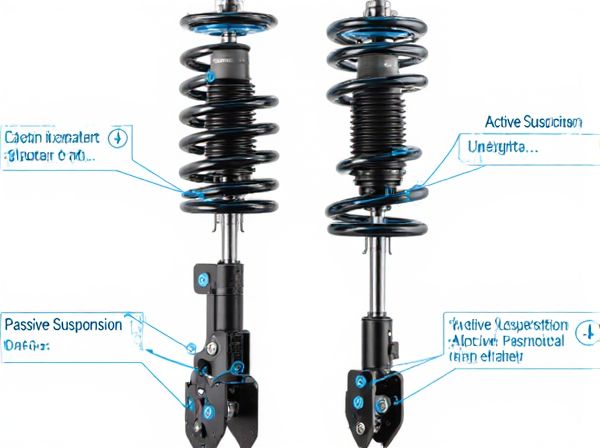
Photo illustration: Passive Suspension vs Active Suspension
Passive suspension uses fixed springs and dampers to absorb shocks, providing a basic level of comfort and stability without adjusting to road conditions. Active suspension continuously adjusts the suspension settings through sensors and actuators to optimize ride quality, handling, and safety in real-time. Your choice between passive and active suspension can significantly impact vehicle performance, comfort, and cost.
Table of Comparison
| Feature | Passive Suspension | Active Suspension |
|---|---|---|
| Technology | Mechanical springs and dampers | Electromechanical or hydraulic actuators with sensors |
| Ride Quality | Basic comfort, limited adaptability | Enhanced comfort with real-time adjustments |
| Handling | Standard handling performance | Improved stability and cornering control |
| Cost | Lower initial and maintenance costs | Higher purchase price and maintenance |
| Complexity | Simple design, easy repair | Complex system requiring specialized servicing |
| Energy Consumption | None | Consumes electrical or hydraulic power |
| Adaptability | Fixed damping rates | Adjustable to road and driving conditions |
| Common Use | Economy and standard vehicles | High-end and performance vehicles |
Introduction to Suspension Systems
Suspension systems play a crucial role in vehicle dynamics by managing the interaction between the wheels and the road surface. Passive suspension uses fixed components like springs and dampers to absorb shocks and maintain ride comfort without external control. In contrast, active suspension employs sensors and actuators to dynamically adjust suspension settings in real-time, improving handling and stability.
What is Passive Suspension?
Passive suspension consists of springs and dampers designed to absorb shocks from road irregularities, providing a balanced compromise between ride comfort and handling stability. It relies solely on mechanical components without external power or adaptive controls, making it simpler and more cost-effective than active suspension systems. The performance of passive suspension is fixed and does not adjust dynamically to changing driving conditions or road surfaces.
Key Features of Passive Suspension
Passive suspension systems rely on fixed springs and dampers to absorb shocks and vibrations from road surfaces, providing a cost-effective and reliable solution with minimal maintenance. These systems do not adjust to changing road conditions or driving dynamics, resulting in consistent but less adaptive ride comfort and handling performance. Key features include simplicity, durability, and energy efficiency, making passive suspensions ideal for standard passenger vehicles and off-road applications where reliability is crucial.
What is Active Suspension?
Active suspension is an advanced vehicle suspension system that uses sensors, electronic control units, and actuators to continuously adjust the suspension settings in real-time for optimal ride comfort and handling. Unlike passive suspension, which relies on fixed springs and dampers, active suspension dynamically responds to road conditions, vehicle speed, and driving style to minimize body roll, pitch, and vibration. This technology enhances vehicle stability, improves traction, and provides a smoother driving experience by actively controlling the suspension components rather than reacting to forces passively.
Key Features of Active Suspension
Active suspension systems use sensors and actuators to continuously adjust the suspension in real-time, optimizing ride comfort and vehicle handling. Unlike passive suspension, which relies on fixed springs and dampers, active suspension dynamically controls damping force and can adapt to road conditions, reducing body roll, pitch, and vibration. This technology improves stability, enhances traction, and provides a smoother driving experience, especially on uneven or rough terrains.
Performance Comparison: Passive vs Active
Passive suspension systems rely on fixed springs and dampers, providing consistent but limited adaptability to road conditions and resulting in less precise handling and comfort. Active suspension uses sensors and actuators to dynamically adjust suspension settings in real time, significantly enhancing vehicle stability, ride comfort, and cornering performance. Performance data indicates active suspension reduces body roll by up to 50% and improves traction, making it superior for handling variability and road irregularities compared to passive systems.
Ride Comfort and Handling Differences
Passive suspension systems rely on fixed springs and dampers that absorb road irregularities, resulting in a compromise between ride comfort and handling performance. Active suspension employs sensors and actuators to adjust damping forces and ride height in real-time, significantly enhancing ride comfort by minimizing vibrations and improving vehicle stability. The adaptive nature of active suspension allows better handling dynamics, especially during cornering and braking, compared to the fixed characteristics of passive suspension.
Cost and Maintenance Considerations
Passive suspension systems generally cost less upfront and require minimal maintenance due to simpler mechanical components such as springs and dampers. Active suspension systems involve higher initial expenses and ongoing maintenance costs because of complex electronic sensors, actuators, and control units integral to their operation. Vehicle owners and fleet managers often weigh the potential performance benefits of active suspension against its increased financial and servicing demands.
Application in Modern Vehicles
Passive suspension systems, relying on springs and dampers, are widely used in economy and mid-range vehicles due to their simplicity and cost-effectiveness. Active suspension technology, utilizing sensors and actuators for real-time adjustments, is increasingly implemented in luxury and performance cars to enhance ride comfort and handling. Modern vehicles equipped with active suspension benefit from improved stability, reduced body roll, and adaptive responses to diverse driving conditions.
Choosing the Right Suspension System
Choosing the right suspension system depends on vehicle performance, comfort requirements, and terrain adaptability. Passive suspension offers simplicity, lower cost, and reliability for everyday driving with fixed damping characteristics. Active suspension provides dynamic adjustment with sensors and actuators, delivering enhanced ride comfort and handling, especially beneficial for high-performance or off-road vehicles.
 caratoz.com
caratoz.com